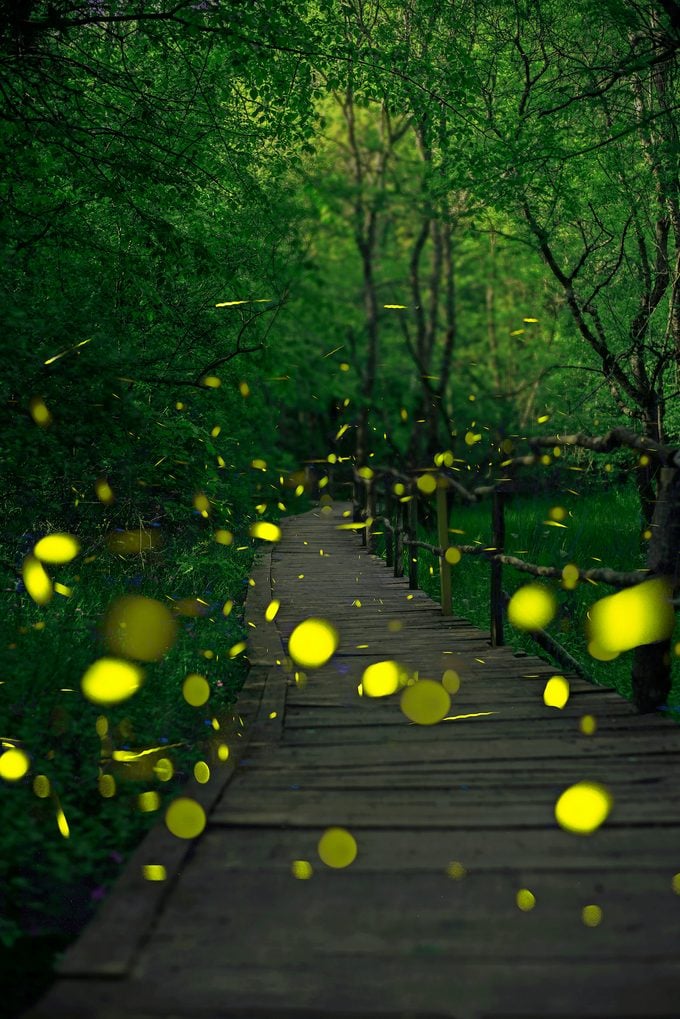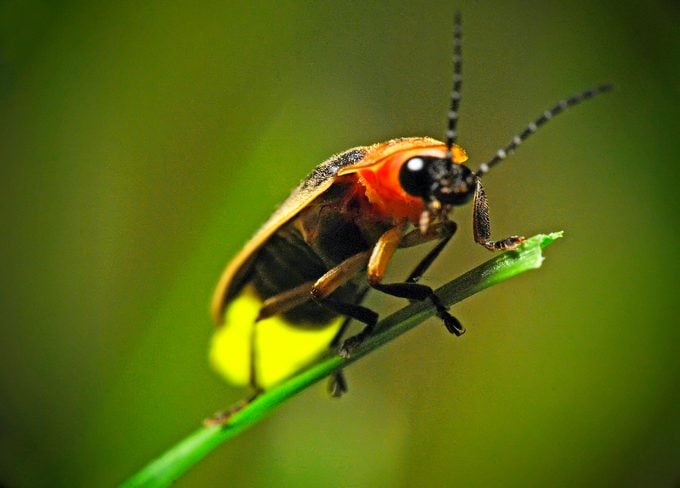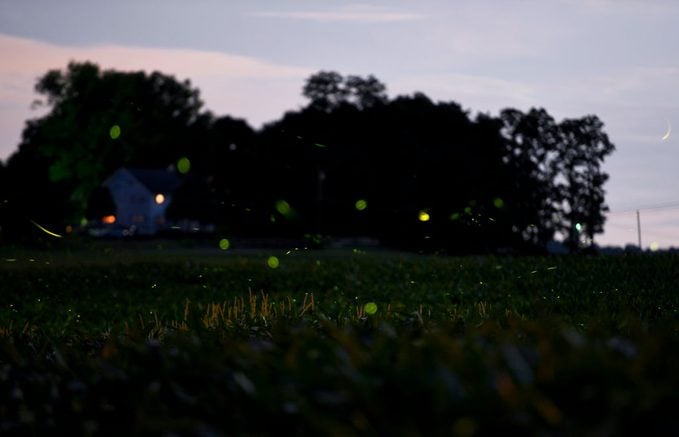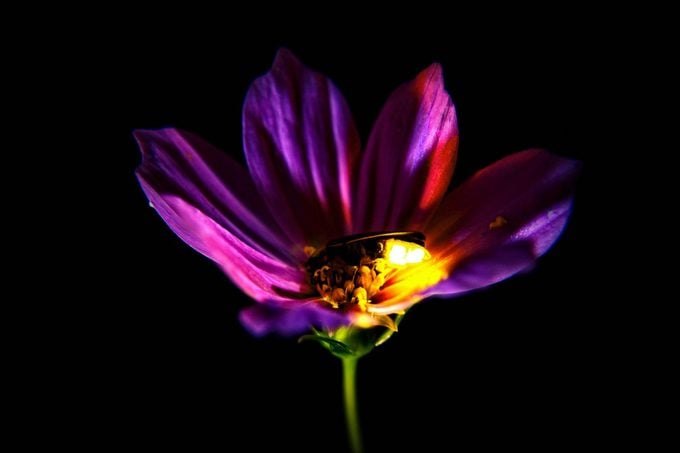Illuminating Lightning Bug Facts You Didn’t Know
Updated: Mar. 12, 2024
Get answers to common lightning bug questions. Find out why lightning bugs light up, when lightning bugs come out and more.
On This Page
Facts About Lightning Bugs

Whether you are lucky enough to see a lightning bug in your backyard or plan to head to a local spot for prime viewing, lightning bugs (aka fireflies) are synonymous with summer. Let’s illuminate some little-known truths about these fascinating, glowing creatures.
Firefly vs Lightning Bug
More than 2,000 species of lightning bugs and fireflies exist worldwide, including 170 in North America. But what’s the correct name? According to Adele Wellman, Allegany region environmental educator for New York State Parks, calling them either fireflies or lightning bugs is fine. “There is no difference between them; they are the same insects,” she says.
Though both names are correct, these flashers are technically neither bugs nor flies. Instead, they are beetles. Next time you’ve got one in your hands, look closely for hardened wing cases, the elytra. This is a key beetle characteristic.
Discover 7 fascinating ladybug facts you didn’t know.
How Long Do Lightning Bugs Live?

“Fireflies go through complete metamorphosis,” Adele says. “They lay eggs in moist areas, and these hatch in about two weeks. The larvae grow for months, pupate underground or beneath tree bark, and then transform into adults.”
Adulthood is short-lived for these beetles. Most adult fireflies survive for just days or weeks.
Ladybug vs Asian beetle: what’s the difference?
Are Lightning Bugs Endangered?
“Growing up in northeast Florida, it seemed like there were thousands of lightning bugs. Now I hardly see any. Where did they go? Will we ever get them back like we used to have them years ago?” asks reader Anita Wilkinson.
Birding experts Kenn and Kimberly Kaufman say, “We agree—these flashing, glowing little insects are among our favorite sights of summer nights! Lightning bugs, also called fireflies, are actually beetles of the family Lampyridae. They’re still abundant in some rural areas, but in many regions their numbers have dropped.
Young fireflies develop in damp places, such as fields and woods near water, and they lose habitat as more and more areas are paved over. They may also be sensitive to pollution and pesticides. Another possible factor is that males and females use light to find each other, so as development brings more bright lights to the outdoors, their mating may be disrupted.”
What Do Lightning Bugs Eat?
Lightning bug larvae are voracious. Adele says that the small, armored, leggy predators live on earthworms, slugs and snails.
Though some adults do not eat at all, the predatory females in the Photuris genus mimic the flashing patterns of other firefly species to lure and eat males.
How and Why Do Lightning Bugs Light Up?
Not all fireflies flash, but both the eggs and larvae glow. Scientists think this is a hint to leave young fireflies alone—a clear warning to would-be attackers of their potentially bitter taste. Adult firefly abdomens have light-producing organs. Within these lanterns, chemicals, enzymes and other compounds mix to produce light.
The blinking rates can help identify different species. “It may take a while for your eyes to adjust, but when they do, note how many different flash patterns you see,” Adele says.
Learn how to control a Japanese beetle infestation.
Some Lightning Bugs Flash in Unison
One fascinating type of firefly flashes in unison. In the U.S., these synchronous fireflies were once thought to live only in the Smoky Mountains, but recently they’ve been discovered in other pockets along the Appalachians. Synchronous fireflies prefer mature, dark forests, according to Adele. One of her favorite programs at Allegany State Park is leading firefly trips that include viewing synchronous species.
See 8 bugs you should never kill in your garden.
When Do Lightning Bugs Come Out?

With so many species worldwide, lightning bugs are found in many habitats, including deep woods, meadows, marshes, swamps and fields. They often like to be near water sources.
“They prefer hot and humid nights,” Adele says. “Heavy rains or cooler temperatures cause them to slow their flash.”
Light hampers fireflies’ ability to see one another, so these bright beetles seek out dark areas. The summer viewing season begins as early as May and lasts until September—peak watching coincides with the warmest months of the year.
If you want to help researchers monitor these bright fliers, record your sightings with the Firefly Watch program.
How to Watch Lightning Bugs
Follow environmental educator Adele’s top hints for observing nature’s fireworks:
- Wear long pants and sleeves. If you must use bug spray to repel biting insects, do not handle fireflies.
- Use a red- or blue-light flashlight to avoid confusing them.
- Walk carefully, as many female fireflies land on the ground.
- Bring a chair or a mat so you can sit back and enjoy the flashing glow.
Next, check out fascinating dragonfly facts you should know.
About the Experts
Adele Wellman is the Allegany region environmental educator for New York State Parks. She has a degree in biology and a special interest in insects, including lightning bugs.
Kenn and Kimberly Kaufman are the authors of the Kaufman Field Guide series and the official birding experts for Birds & Blooms.
Sources
- https://www.firefly.org/
- Scientific American
- Mass Audubon
- Merriam-Webster dictionary
- National Wildlife Federation
- Proceedings of the National Academy of Sciences
Why Trust Us
For nearly 30 years, Birds & Blooms, a Trusted Media Brand, has been inspiring readers to have a lifelong love of birding, gardening and nature. We are the #1 bird and garden magazine in North America and a trusted online resource for over 15 million outdoor enthusiasts annually. Our library of thousands of informative articles and how-tos has been written by trusted journalists and fact-checked by bird and garden experts for accuracy. In addition to our staff of experienced gardeners and bird-watchers, we hire individuals who have years of education and hands-on experience with birding, bird feeding, gardening, butterflies, bugs and more. Learn more about Birds & Blooms, our field editor program, and our submission guidelines.























